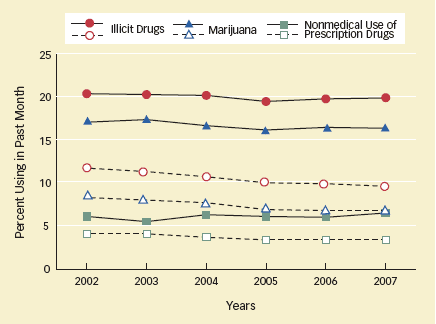The percentage of young adults who said they were abusing cocaine or methamphetamine dropped substantially from 2006 to 2007, according to the 2007 National Survey on Drug Use and Health (NSDUH), published in September 2008. Overall drug abuse, however, remained constant: According to the survey, an estimated 19.9 million Americans age 12 and over used an illicit drug in the previous month. That rate has held steady since 2002.
 Illicit Drug Use Among Youths and Young Adults: Youths (age 12 to 17) have lower rates of drug use than young adults (age 18 to 25). Youth rates (open symbols, broken lines) have fallen gradually, while the young adult (filled symbols, solid lines) rates have remained level.
Illicit Drug Use Among Youths and Young Adults: Youths (age 12 to 17) have lower rates of drug use than young adults (age 18 to 25). Youth rates (open symbols, broken lines) have fallen gradually, while the young adult (filled symbols, solid lines) rates have remained level.As in past years, young adults (aged 18-25) reported the highest rates of substance abuse. About 20 percent said they abused one or more illicit drugs; 16.4 percent said they abused marijuana, which topped the list of abused drugs in this cohort. Abuse rates for marijuana and most of the other drugs have changed little in the past 6 years. However, the decline in abuse of the stimulants cocaine and methamphetamine in this group runs counter to that pattern. In 2007, for example, 1.7 percent of the young adults reported cocaine abuse, a 23 percent decline from the previous year. Methamphetamine abuse in this age group dropped by a third, to 0.4 percent.
By contrast, 12- to 17-year-olds have reported a steady decline in overall illicit drug use, from 11.6 percent in 2002 to 9.5 percent in 2007. Driving the decline in this cohort has been an 18 percent drop in marijuana use, from 8.2 percent in 2002 to 6.7 percent in 2007. Inhalants are the only drug category that showed no decline among adolescents over that 6-year period, although rates for some drugs have leveled off since 2005.
Rates of drug abuse tend to decline steadily after the age of 25. However, as more baby boomers (people born between 1946 and 1964) enter the 50-59 age range, illicit drug use in that group has risen, jumping from 2.7 percent in 2002 to 5 percent in 2007. "Illicit drug use has historically been more prevalent in the baby boomer cohort. As its members age into the 50-59 age category, the prevalence increases relative to prior cohorts in this age group," says Dr. Marsha Lopez of NIDA's Division of Epidemiology, Services and Prevention Research.
Marijuana remains the most commonly used illicit drug across the survey, with an estimated 14.4 million past-month users. In 2007, roughly 2.1 million people smoked marijuana for the first time, and a similar number started using prescription painkillers for nonmedical purposes; these drugs drew more initiates last year than any other. Of the estimated 6.9 million people who used prescription psychotherapeutic drugs nonmedically, 5.2 million chose painkillers, representing a 16 percent rise in nonmedical use of these drugs since 2004. On a positive note, the 2007 survey found a significant 1-year decline in the nonmedical use of prescribed stimulants.
In 2007, as in previous years, men reported higher rates of past-month illicit drug use than women (10.4 percent versus 5.8 percent). Among ethnic groups, American Indians/Alaska natives had the highest rate of illicit drug use (12.6 percent) of any racial/ethnic group, followed by multiracial individuals (11.8 percent), African-Americans (9.5 percent), whites (8.2 percent), Hispanics (6.6 percent), and Asians (4.2 percent). No group had a significant change from the previous year.
The trends determined by NSDUH for adolescents and young adults are generally consistent with those reported by the NIDA-funded Monitoring the Future survey. (For more information, see NIDA Notes, Volume 21, Number 5, March 2008, page 15). The survey, based on the responses of 67,500 participants, is available online at www.samhsa.gov/data/population-data-nsduh. Hard copies can be ordered free by calling (800) 729-6686.
Source
Substance Abuse and Mental Health Services Administration, 2008. Results from the 2007 National Survey on Drug Use and Health: National Findings (Office of Applied Studies, DHHS Publication No. SMA 08-4343). Rockville, MD: SAMHSA.
